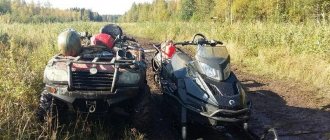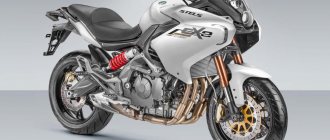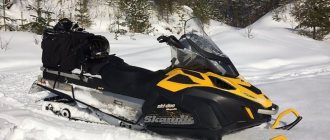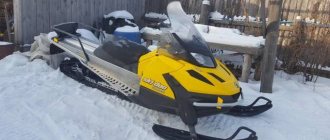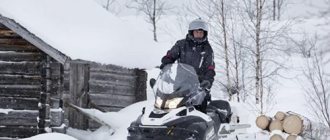2014 Ski-Doo Expedition Sport ACE 900 Review
Long utilitarian touring snowmobile with an economical engine
Ski-Doo marketers identify every conceivable niche in the snowmobile market and immediately rush to fill them. Some of them may seem strange and completely far-fetched to us, but the company is making every effort to find ways to increase sales and its market share.
At first glance, Ski-Doo's Expedition series of snowmobiles seems insignificant at best. Obviously, the company itself doesn't think so, because there are three Expedition variants available: SE, LE and Sport. Among these three variants, there are two models of the top SE. Add in two LE models and three Sport configurations for a total of seven versions of the Expedition for the 2014 model year.
The Expedition Sport is sure to be used as a utilitarian sled with a casual riding style.
The top-of-the-line Expedition SE model with the 1200 4-TEC engine will cost around 750,000. The Expedition Sport with the air-cooled 550cc 2-stroke 2-cylinder engine will cost you less. We wouldn't recommend this option unless you're renting snowmobiles and would rather save money on the purchase. If you're looking for a well-equipped two-seat touring/utility sled, we'd recommend the Expedition Sport with the latest ACE 900 3-cylinder, 4-stroke engine.
Why would we recommend the ACE 900 for the Expedition Sport? This engine is better equipped than most to pull a 253 kg sled (standard) with two passengers and luggage. The ACE 900, with its excellent low- and mid-range performance, belongs here. In addition, Ski-Doo managed to set a very tempting price for this configuration.
As a sports engine, the ACE 900 is unlikely to impress, but for touring and utilitarian models it is just fine. Since it is based on the proven ACE 600 twin-cylinder 60 horsepower, you can expect the engine to be reliable and strong. These are exactly the qualities needed in a snowmobile on which drivers will go into the unknown tundra or European steppes.
This is a cutaway view of the 2014 ACE 900 3 cylinder 4 stroke. The long intake pipes and 46mm throttle body are visible.
The Expedition Sport ACE 900 is strong not only in torque, but also in its electrical equipment. A standard 420 V magneto serves for heating and everything else. Torque is sent from the engine to the Charger's 154-inch truck via Ski-Doo's proprietary eDrive2 drive system. This new drive system is a new version of the original eDrive that debuted in 2011 on the ACE 600 4-stroke.
Ski-Doo used eDrive2 on their 3-cylinder 4-TEC 1200 as a TRA replacement. eDrive2 is a significant upgrade, better able to cope with more powerful engines such as the 120bhp 1200. and ACE 900 with 90 hp. The eDrive2 system makes better use of the advantages of 4-stroke engines overall.
The Expedition Sport ACE 900 benefits from other benefits of the eDrive2 drive system: longer belt life, improved heat transfer, and 680 grams less rotating weight. Thanks to the increased number of rotating cylinders, sliders and other system elements, gear shifting and engine torque are improved.
The gas cap reminds you that the ACE 900 runs on regular fuel, even when the ECO mode is activated for the lowest consumption.
The ACE 900 is a continuation of the Advanced Combustion Efficiency (ACE) engine series from Rotax. While the ACE 600, the first of the ACE models, is a 2-cylinder engine, the ACE 900 adds one cylinder, resulting in 330 cubic centimeters of volume and 30 horsepower.
Despite its low price, the Expedition Sport ACE 900 is built on the latest stylish REV-XS platform.
What makes the Ace 900 truly unique is the electronic throttle control system we often see on cars. Ski-Doo called this system "Intelligent Throttle Control" (ITC). Since the throttle is now controlled by electronic ITC, the three engine modes can be switched by simply pressing a button on the dashboard. Three modes are available: Standard, Sport and ECO. Standard mode provides a smooth start and uniform acceleration, and also limits torque above a certain speed. There are no restrictions when Sport mode is activated. And finally, the ECO mode is programmed to limit torque, maximum speed and acceleration in order to maximize fuel efficiency.
Motion Control front shock absorbers account for the Expedition's 8.3 inches of vertical suspension travel.
Ski-Doo also added “learning key” technology, borrowing it from Sea-Doo jet skis. As with jet skis, the key can be programmed to limit the maximum speed. The technology pairs well with the engine, which is also found on the new 2014 Spark watercraft from Sea-Doo.
The Expedition Sport ACE 900 is perhaps our favorite of all the Expedition models, simply because it's what you need and at a very reasonable price. Of course, a snowmobile with a footprint of 2,464 square inches and a weight of 253 kilograms is not going to be fast. But such a huge truck (16 inches wide, 154 inches long) allows you to confidently go on long journeys. And with a tow bar and rack as standard, the snowmobile is ready to go. And then the ACE 900 will really come into place, and not the basic 550 cc 2-cylinder engine or the 4-stroke ACE 600 with 60 “horses”.
Among other advantages of the Expedition Sport ACE 900, one cannot fail to mention the new, more agile REV-XS chassis. Also pleasing is the rear suspension, which features an articulating design that makes boondocking easier, and a tool-free suspension locking mechanism. Combine this with adjustable ski spacing and you have a very flexible sled.
But not everyone will like such a large snowmobile. Its length is 131.6 inches (334 cm). However, the Expedition series is an excellent hybrid between a full-fledged touring snowmobile and a purely utilitarian work snowmobile.
The 154-inch track rotates around a flexible, articulated rear suspension.
Most likely, the snowmobile will find its buyer outside the North American market, where good groomed snowmobile trails are more of a dream than a reality. If you own a snowmobile rental business and are looking for a model that any newbie can saddle up and ride during the day without risking getting into trouble, then this is your option. Cross-country ability, stability, modest gas mileage and a “smart key” with the ability to customize the snowmobile’s parameters for the driver – everything is in place.
Ski-Doo is looking for market niches where others haven't thought to look. The Expedition series, which has expanded Ski-Doo's portfolio and potentially increased sales, is a case in point. And increased sales mean increased market share, which is what Ski-Doo wants.
2014 Ski-Doo Expedition Sport ACE 900 Specifications | |
| Engine | 3-cylinder, 4-stroke Rotax 899 cc. cm.; ACE (Advanced Combustion Engine) with 46 mm. throttle body; three operating modes (Sport, Standard, ECO) |
| Power | 90 hp (stated) |
| Drive unit | Ski-Doo/Rotax eDrive2; QRS |
| Brakes | Brembo hydraulic brake system with stainless steel brake line |
| Front suspension | Double wishbone with Motion Control gas shock absorbers; travel – 8.3 inches |
| Rear suspension | SC-5U with Motion Control shock absorber in the center and HPG in the rear; travel – 13.4 inches |
| Length | 131.6 inches |
| Width | 47.4 inches (maximum) |
| Height | 50.2 inches |
| Distance between skis | 38.4 – 40.1 inches (adjustable) |
| Truck | 16 x 154 x 1.5 Charger |
| Weight | 253 kg. (stated) |
| Tank capacity | 40 l. |
| Equipment | Rear suspension on hinges, seat for two, electric starter, reverse, analog instrument panel, three engine modes, learning key, tow bar, trunk, seat list |
Ski-Doo Skandic WT 900 Ace – TEST
TREND
2015, 899 cm3, 90 l. s., 297 kg, 1,120,000 rubles (2017)
text: Yuri Solonovich photo: “Rosan” and Dmitry Kuzmin
in the photo: Yuri Solonovich
»Today we are so accustomed to the achievements of modern civilization that we practically do not notice the most obviously incredible things around us. Just 10–15 years ago, no one could even dream of, for example, a mobile communications network that would cover almost the entire world, FidoNet users would hardly have believed in affordable and widespread high-speed Internet, and proud owners of personal computers with Intel 486 processors would have wept bitterly , find out the technical characteristics of any modern smartphone.
It is these achievements of modern civilization that have greatly spoiled the modern buyer. It is no longer enough for him to simply buy a functional and long-lasting item - comfort and ease of use are valued today no less than maintainability and reliability. So, the not very comfortable cars of the classic Lada family, primitive push-button Nokia phones and utilitarian snowmobiles, structurally simple as the MV-2.5A thresher-winnower, will inevitably sink into oblivion - it’s only a matter of time. In modern realities, almost all leading snowmobile manufacturers are in constant creative and engineering search, trying to figure out a new formula for the ideal utilitarian machine. The most modern technical developments are being used, and therefore sports chassis and Hi-Tech power plants are already found everywhere. Of course, 2-stroke engines will not lose ground for a long time, but today they have acquired fuel injection systems and clever devices that help them squeeze through the fine sieve of environmental prohibitions and restrictions. However, today, to create the ideal universal touring snowmobile of the 21st century, as a rule, economical 4-stroke engines are used.
The Canadian company BRP, being at the forefront of snowmobile scientific and technological progress, put such a progressive engine into mass production several years ago: we are talking about a 90-horsepower 4-stroke in-line “three” Rotax ACE 900 with a displacement of 899 cm3, equipped with a liquid fuel system. cooling and with a “dry” sump. The power plant is equipped with a cableless iTC (Intelligent Throttle Control) throttle control system, which allows you to simply switch between three engine operating modes at the touch of a button. In Standard mode, the snowmobile starts smoothly and accelerates evenly, but the control unit forcibly “pulls” the engine at maximum speed. In Sport mode you can rev the engine without any restrictions. Well, in ECO mode the electronic “collars” are configured for maximum fuel economy. The throttle valve is controlled by an electronic throttle trigger - no cables or additional mechanical devices: all manipulations take place “by wire”! And at the same time the trigger is rotary. That is, if desired, you can rotate it so that you can press it with your index finger.
The steering column of the Ski-Doo Skandic 900 Ace can be adjusted in angle. Traditional BRP snowmobile multifunctional instrument panel with dial tachometer and speedometer.
The 3-cylinder design provides the Ski-Doo power plant with a very “torque” character from the very “bottom” and a vigorous “top”. At the same time, the engine is environmentally friendly and has good fuel efficiency. Also, the undoubted advantages of the Rotax ACE 900 include its compactness, which made it possible to install this engine on various vehicles. The engine originally appeared on the Ski-Doo Expedition Sport 900 ACE touring snowmobile a couple of years ago, and a year later it was implanted into the plastic body... of the Sea-Doo Spark jet ski! And in the seasons starting from 2014, the power plant can already be seen on utilitarian BRP and Lynx snowmobiles. One of those lucky enough to receive such a progressive 4-stroke “heart” was the legendary Ski-Doo Skandic. This, by the way, is one of the most popular and long-lasting models of the Canadian concern, which has been coming off the assembly line in one form or another for about 20 years! The sled is built on a lightweight, strong and rigid REV-XU aluminum platform with a traditional LTS telescopic front suspension with 150 mm of travel. The SC-5U's 356 mm rear suspension adjusts to one of five angles of attack, reducing cornering drag and improving reversing in deep snow. The machine is equipped with a track 3920 mm long and traditional for Wide Track machines with a width of 500 mm. In general, the Skandic 900 Ace is practically no different from its 2-stroke counterparts. Nothing but the engine!
Heating the steering wheel grips and the gas trigger for a utilitarian car are elements of the most basic necessity. When you press the Eco button, the snowmobile becomes gentle and obedient, like a beloved pet! And, importantly, very economical.
In general, the appearance of such a multifunctional power plant on the company’s utilitarian snowmobiles is very justified and timely. If you look at it, the buyer receives an almost perfect “junk”, powered by a light, compact and quite powerful 4-stroke engine. This is probably the future! Down with short service intervals! Bringing fuel efficiency to the wide snowmobile masses! Damn the nervous nature of the traditional two-stroke! Comfort and smoothness are in fashion!.. Riding such a snowmobile, despite all its purely utilitarian essence, is a pleasure. The energy-intensive front telescopes and rear shock absorbers, wide track, Pilot DS 2 skis and the special streamlined shape of the front end of the snowmobile give the Ski-Doo Skandic WT 900 Ace amazing all-climbability. In deep snow, it is able to float through snow masses and feel confident on compacted surfaces. Thanks to its linear nature, the powerful but controllable engine allows you to move away even in very deep snow without much fear of digging up to the steering wheel grip. And with skillful handling of the throttle trigger, the 900 ACE allows you to confidently start in powder even with heavy sleds.
Of course, Ski-Doo Skandic WT 900 Ace is more expensive than its 2-stroke brothers Skandic WT 550 or Skandic WT 600 HO E-TEC and the younger model Skandic WT 600 Ace. And, of course, the potential buyer will have to choose. It is he who will vote with rubles for this or that version of the snowmobile. But personally, if I had the opportunity to choose and have the financial reserve, I would prefer a car with a 900 Ace engine, because, all other performance being equal, a snowmobile with such an engine is much more comfortable and enjoyable than its not so technically advanced counterparts. /



